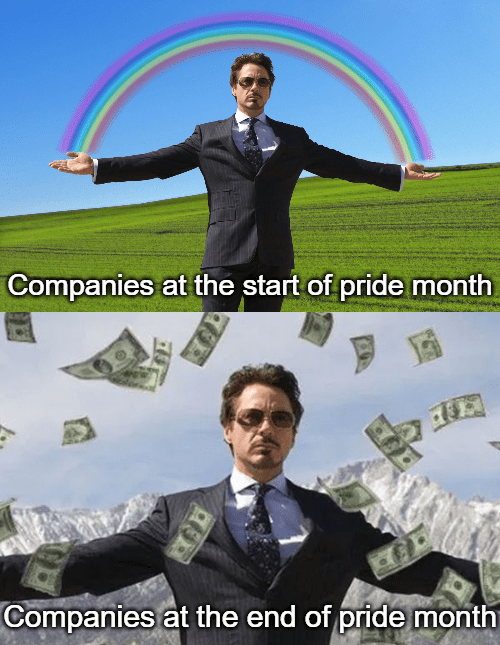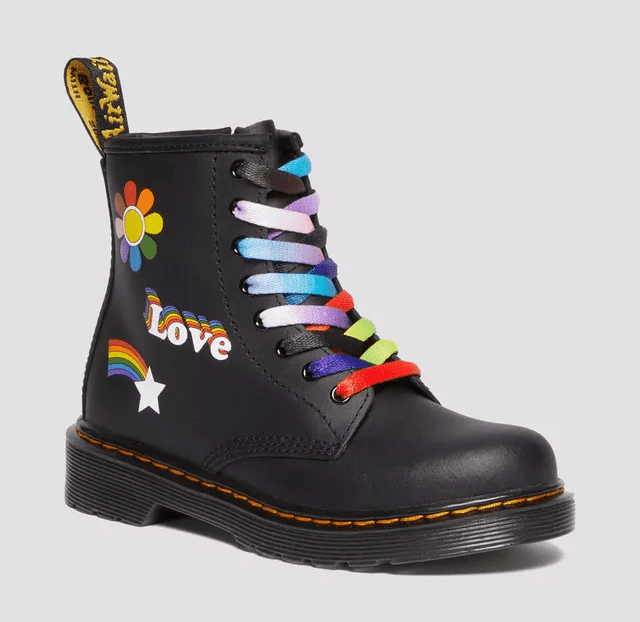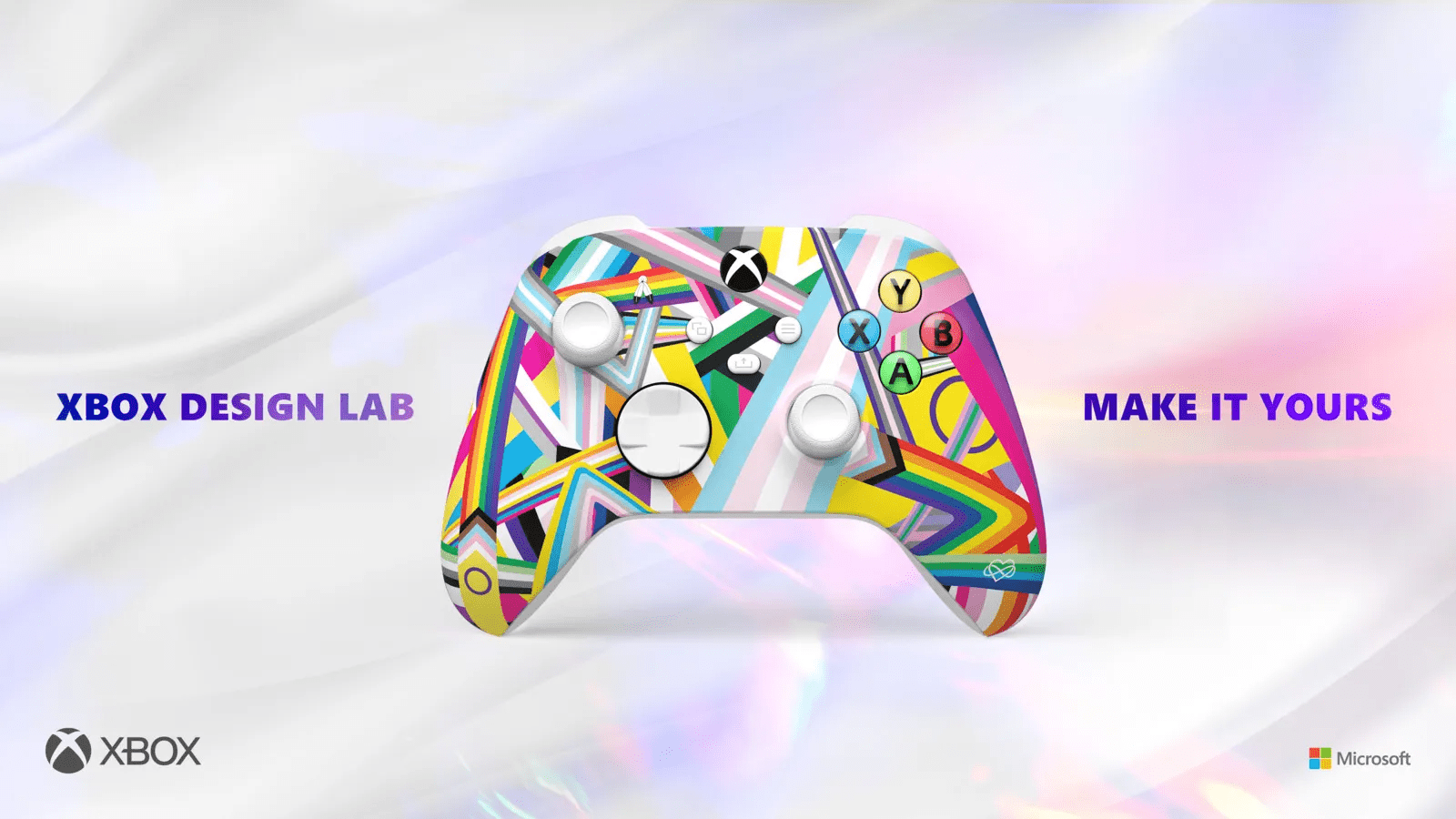Should Your Brand Use a Pride Month Logo This Year?
Plenty of small and mid-sized businesses fly the pride flag year-round to say either 1) this is a queer-operated establishment or 2) we are allies — this is a safe place to hang out and be gay all day.
But what about brands that only mention pride during June? What does that signal to customers and other businesses? We’re going to answer that question, and also explore when using a rainbow logo during June is a good idea.
So let’s get down to business. Should you use a pride month logo as part of your marketing strategy? Well, the answer is sort of complicated.

Why do businesses rebrand for Pride?
First, a quick note on vocabulary. In this blog, you’re going to see the word queer. While generations of people have weaponized it as a slur, some of us, myself included, have chosen to reclaim it as an all-encompassing term for members of the LGBTQIAP2S+ community. Others have not. Neither group is wrong.
To the question at hand: If a business “brands” its property, web content, or products with the pride flag only during the month of June, the reason is almost always to make more money from queer people and our allies.
This doesn’t mean the business isn’t an ally. Plenty of businesses are strong allies — putting their money behind queer causes, employing (and listening to the voices of) queer employees, and speaking out against anti-gay and anti-trans activity.
But if your support isn’t extended to the queer community in the other 11 months of the year, your pride rebranding might come across as disingenuous. The same can be said about Black History Month, Breast Cancer Awareness, and countless other examples.
Rebranding responsibly starts with a year-long commitment to queer allyship, and also a familiarity with crucial moments in queer history.
What does the rainbow flag represent?
In 1978, when the late activist Harvey Milk (the first openly gay man elected to public office in California) wanted to adopt a symbol of pride for the gay community. He knew a “brand” would unify the activists. He turned to designer and U.S. Army veteran Gilbert Baker.
Along with a small group of other troublemakers, Baker decided to use the most iconic representation of pride — a flag. For inspiration, he looked to the skies. Favoring a rainbow pattern (it’s pretty, identifiable, and reflects diversity), Baker chose eight stripes: the standard seven natural colors, plus a touch of hot pink.
After Harvey Milk’s assassination later that year, retail demand for the flag exploded in San Francisco and, eventually, across the nation. The pink stripe was eventually dropped as the fabric was hard to find. To even out the number of stripes (it’s better for design), Baker combined the turquoise and indigo stripes to form a single blue one. And thus, the ubiquitous six-color flag was born *throws glitter*.
Since then it’s been found everywhere from face tattoos to cereal boxes to the front of the Obama White House. More than 50 variations currently exist — each representing a different queer identity or location (lesbian, asexual, non-binary, etc.), including the increasingly popular transgender flag, created by Monica Helms — another military veteran — in 1999.

The first pride “parade” was a literal riot that was led primarily by Black trans women as they fought back against the abusive NYPD outside the Stonewall Inn for three entire days in 1969.
In 2018, non-binary American artist Daniel Quasar developed the (sometimes controversial) Progress Pride Flag, which includes black and brown stripes highlighting the often overlooked BIPOC (Black, Indigenous, and People of Color) queer community that planted the seeds of Pride back in 1969. With the trans flag, these form an arrow — a much stronger representation of queer intersectionality.
When is it a good idea to use a Pride Month logo?
While the best time to use a pride flag to represent your organization’s values is every single day, there are plenty of queer folks who, understandably, believe that any pro-queer visibility is helpful.
But many others, with equal justification, look at the one-month pride cycle with skepticism (to say the least). Where were these organizations before gay marriage was legalized? Before allyship became trendy — and largely without risk. Before Will & Grace and RuPaul’s Drag Race? Where were these companies when we needed them the most? Where were they in May?
What the queer community needs right now is legislative support. And if there’s one thing politicians understand — it’s corporate pressure.
Get loud. Get angry. And donate to nonprofit organizations that are working at the grassroots level.
Keep in mind your pride statements are part of a bigger picture. Don’t use the rainbow and then support events taking place in countries with human rights abuses. Or other institutions that support anti-queer agendas.

What are the drawbacks of Pride rebranding?
Supporting any marginalized group comes with risks. Depending on who that is, the risk level varies.
Queer people are skeptical.
As I’ve said above, be prepared to put your money, and your political push, where your rainbow is. The queer community is becoming increasingly cynical about rainbow-washing, so it’s going to take some convincing to show that you actually care.
Haters gonna hate.
Many of us saw what happened with Bud Light. They took a financial and political risk by (gasp) partnering with trans actress Dylan Mulvaney, who promoted a Bud Light contest on TikTok.
In response, conservatives started posting videos of themselves pouring out cans of Bud Light. Mind you, Bud Light has been doing this for years, including creating ad content about hot gay cowboys. You can’t always anticipate when an anti-queer backlash will happen.
But all publicity is good publicity as far as many mega-brands are concerned. They were likely ready with their feeble non-response, too.
So be ready for backlash, and be ready to tough it out and stand behind your approach.
Don’t pull a move like Target just did.
If you back down, and cave to anti-queer rhetoric and threats, you’ve lost much of that brand loyalty you’ve spent years cultivating with queer folks.
It’s an investment.
A simple digital brand redesign might not cost much. But if you’re dealing with packaging and clothing, you’ve got to consider not only your design and printing cost, but what do you do with all that inventory when July 1 hits? Many companies are so married to the Pride Month idea that they’ll actually scrap that inventory.
If you’re going to spend money putting rainbows on candy wrappers, I’d rather you send that money to a local trans organization. If you’re not going to stick with us, don’t try me.
5 Pride month logos that we love
There’s been a meme floating around for several years that emphasizes a really key point about rainbow capitalism. Even the most evil of corporations will try to get that Gay Money. Have some fun Googling these fictional villainous corporations.

1. Accenture

I love the simplicity of the logo, plus its inclusion of the progress pride flag elements in the bottom half. The clear implication of “greater” is already embedded in their logo, and works even better here. The accompanying statement is a fluffy one, but it’s backed up by their work as a pro-queer workplace. Having queer leadership will do that.
2. Microsoft Windows

In 2021, Microsoft employees celebrated pride by organizing to create a series of dazzling and unique ads, desktop backgrounds, Xbox controllers, and even a car. But it’s this tweet from their Windows account that is clear, fresh, and funny to those of the early Windows generation.
3. Doc Martens


The doctor has been doing pride properly for years — with impeccable web design and layout that shows the faces of all kinds of queer folks and uses colors that go far beyond the six-rainbow flag. What’s more important — they support pride year-round through political action, advocacy training, and donations. This year their pride logo isn’t online, but on the “1460 for Pride” lace-up leather boot. With toddler and junior sizes available, even the young’uns can get in on the hippie-inspired fun.
4. Microsoft Xbox

Xbox has been allowing folks to play around with their design lab for a while now. If they like it, they’ll sell it. Last year, Polygon developed a bespoke queer flag controller that ended up taking off. Plus: Microsoft’s pride content is developed and designed by a team of queer employees — and Microsoft continues to donate money to various queer organizations.
5. University of Arizona


The best of the best, not just for queer pride and history, but a variety of marginalized cultural groups. The school’s logo is replaced by dozens of small icons, each with a unique meaning relevant to the culture. Below it, a key of meanings plus a paragraph explanation for each. Not only is it a boost of visual awareness — it’s an educational tool. They are even open to requests for new cultural logos.
How we celebrate Pride Month at Big Sea
We don’t.
And you know why? Because we embrace our queer employees every day. We hire queer people, put them in leadership positions, and nurture their professional and personal growth. We support our team members seeking gender-affirming and reproductive care when insurance plans fall short. From account managers to designers to writers to web developers — our team is filled with queer people and their allies. And we work with clients that align with these values.
And none of this is performative. It’s not fabricated to sell our services, to get retweets, or win awards. When things happen to the queer community, we have something to say about it. And it doesn’t have to be in June.
